Best Practices for Shade Matching in Dentistry
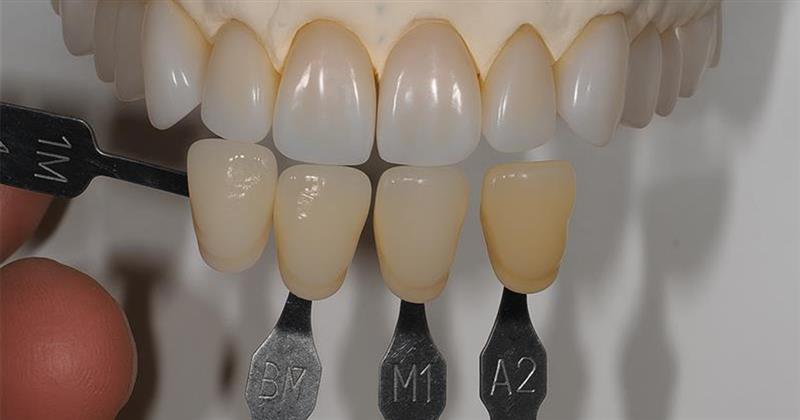
Achieving a beautiful, naturallooking restoration isn’t just about using the best materials-it begins with accurately matching the shade of the patient’s teeth. Shade matching is the process of selecting a restoration colour that harmonizes with the surrounding dentition. A mismatch can undermine the aesthetic outcome and patient satisfaction. Successful shade matching requires understanding colour science and the variables that affect perception.
What is shade matching and why does it matter?
Natural tooth colour is a combination of hue, value and chroma -hue denotes the basic colour tone, value represents lightness or darkness and chroma describes saturation. Many restorations fail because the chosen shade does not reflect these dimensions accurately. Modern dental shade guides (e.g., the Vita shade guide or Vita 3DMaster) translate the hue-value-chroma system into practical shade tabs that clinicians can compare directly with a tooth surface. However, colour perception is subjective; age, gender and even medications influence how observers perceive colour. Recognizing these variables helps clinicians plan accordingly.
Factors affecting shade matching
Shade matching is influenced by multiple variables related to the environment, the tooth and the observer. Important factors include:
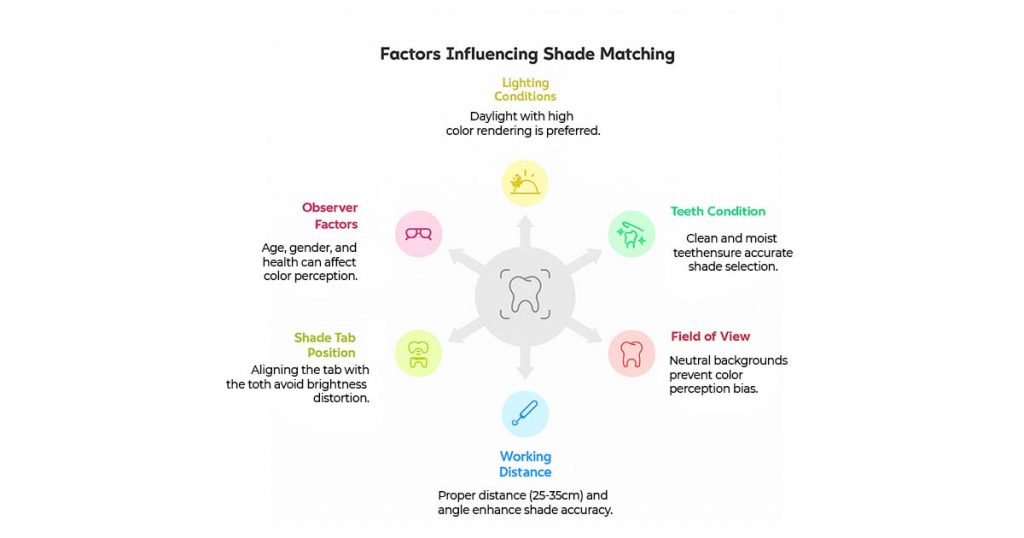
- Lighting conditions– Light source type, colour temperature and intensity all influence how teeth appear. Standard daylight with a high colourrendering index is ideal. Dental unit lights are usually too bright and can create glare.
- Teeth condition-Teeth must be clean and moist. Plaque or stains should be removed, and shade selection should occur before procedures that dehydrate enamel because dehydration makes teeth look lighter.
- Field of view – Brightly coloured lipstick, clothing or gloves can bias perception. A neutral grey background (e.g., grey bib or wall) is recommended
- Working distance and angle – Patients should sit upright; the clinician should view the tooth at eye level from 2535 cm and recheck the shade at least twice.
- Position of the shade tab – Holding a shade tab in line with the tooth avoids making it appear brighter or darker.
- Observer factors – Ageing eyes may favour yellowbrown hues. Women often perceive subtle colour differences better than men while drugs such as sildenafil or longterm oral contraceptives may alter colour vision. Colourvision deficiencies further complicate shade selection, so clinicians should be aware of their own limitations.
- Eye fatigue – Prolonged staring reduces the ability to differentiate hues. Short glances of 2–3 seconds with rest periods help prevent afterimages
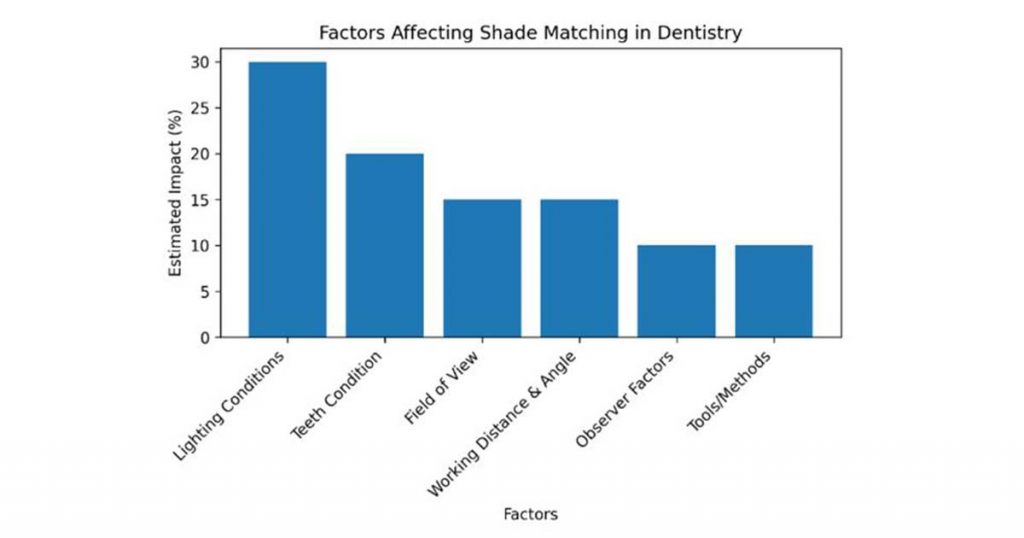
Visualizing the influence of different factors
The estimated impact of various categories of factors on shadematching outcomes is illustrated above. Lighting conditions often contribute the largest share of mismatches, followed by the condition of the teeth and environmental variables. Observerrelated factors (age, medications, fatigue) and equipment choices also play significant roles.
The values are approximate and for illustrative purposes. Actual influence varies with clinical conditions.
Methods of shade matching
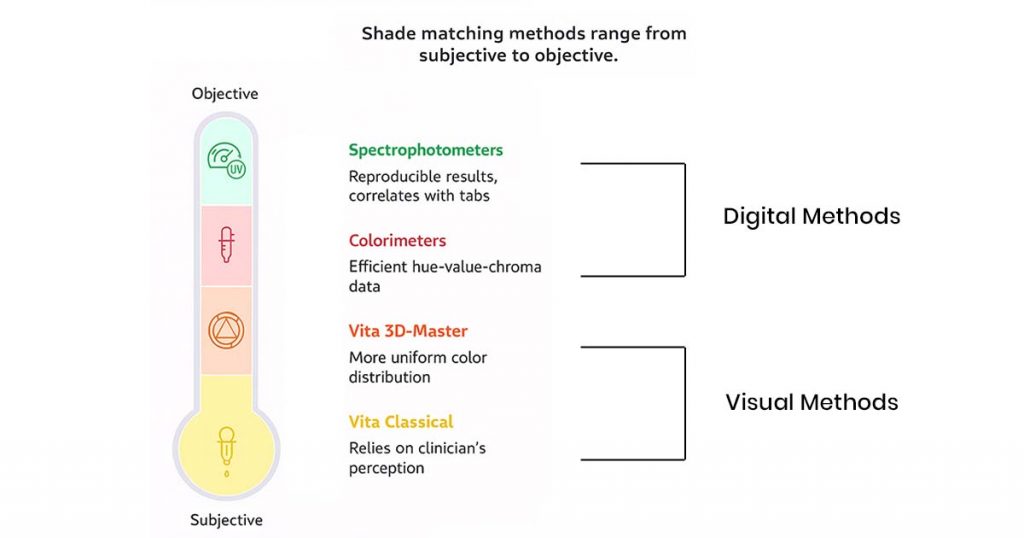
Visual shade guides
Conventional shade selection relies on visual comparison using a shade guide. The Vita Classical shade guide divides tooth colour into four groups (A = redbrown, B = yellow, C = gray, D = redgray) with numbered tabs from 1 to 4 to represent increasing chroma. The Vita Toothguide 3d-Master with Bleached Shades guide improves on this by offering more uniform distribution across the colour space and including dedicated bleach shades. Shade matching success depends entirely on the clinician’s colour perception.
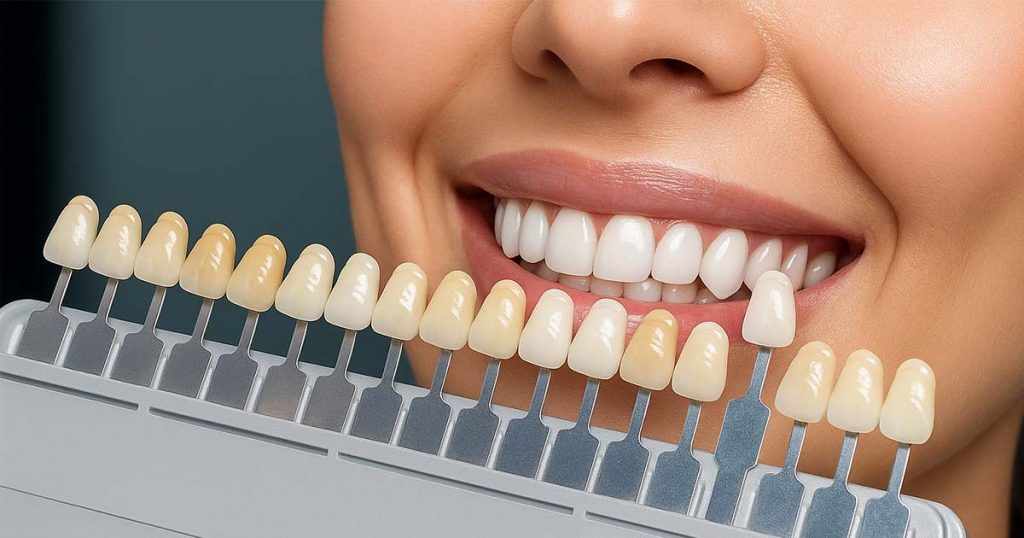
Digital shade matching devices
To reduce subjectivity, many practices employ digital instruments:
- Spectrophotometers measure the light reflected from a tooth across many wavelengths and convert the data into shade values. Devices such as Waldent ShadePro Digital Shade Determination Device, provide reproducible results and can correlate readings with specific shade tabs.
- Colorimeters filter light into red, green and blue components and record tristimulus values. While less detailed than spectrophotometers, colorimeters deliver efficient hue–value–chroma data and store only three data points.
- Digital photography and smartphones are not colourmeasuring devices but enhance communication with laboratories. Including a shade tab in the photograph allows technicians to compare tooth colour to the chosen reference Clinical photographs should be taken with a macro lens and ring flash to ensure proper exposure and minimal distortion.
These instruments mitigate environmental influences by using colourcorrected light sources and provide consistent data. However, they require investment and training.
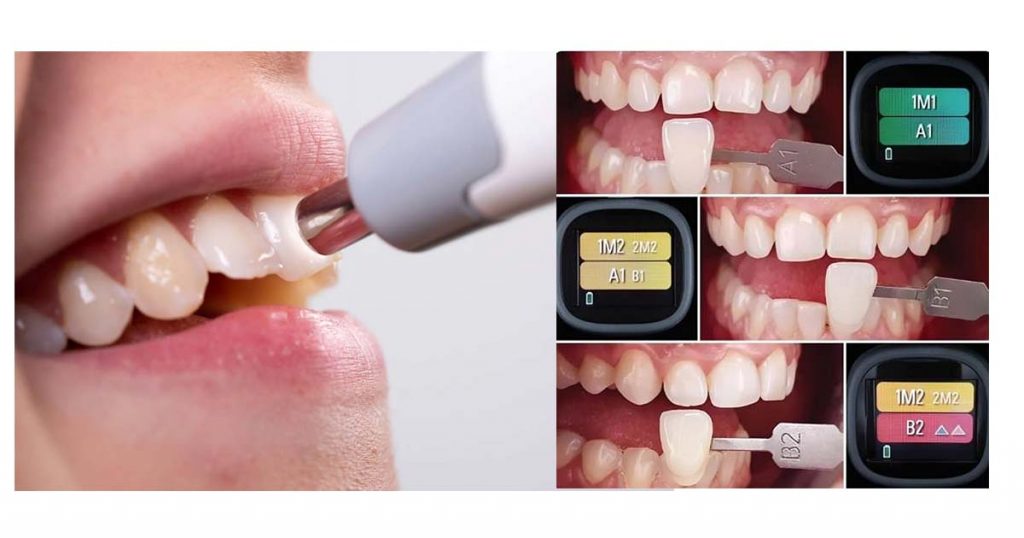
Best practices for shade matching
Synthesizing guidance from the literature and clinical experience, the following practices improve shade matching accuracy. Implementing several of these steps together yields the best results.
| Best practice | Explanation & supporting evidence |
| Use a recognized shade guide | Employ a standardized dental shade guide such as the Vita shade guide (Classical or 3DMaster) to provide a common reference for clinicians and laboratories. |
| Select shade at the beginning of the appointment | Determine the shade before tooth preparation to avoid dehydration, as teeth become lighter and less chromatic when dry. |
| Ensure teeth are clean and moist | Remove plaque and stains prior to shade matching and keep the teeth hydrated to reflect their true colour. |
| Prepare the viewing environment | Use a neutral grey background, ask patients to remove brightly coloured lipstick or clothing and wear neutral gloves. A neutral light grey room and a blue bib help relax the eyes. |
| View at eye level and use short glances | Sit the patient upright, view the tooth at eye level from 25–35 cm and verify the shade on more than one occasion. Take quick glances (2–3 seconds) with rest periods to avoid eye fatigue and afterimages. |
| Position the shade tab correctly | Hold the shade tab in line with the tooth rather than in front or behind, as misplacement alters perceived brightness. |
| Compare under multiple light sources and verify | Check the selected shade under daylight and operatory lighting to avoid metamerism Digital devices with colourcorrected light sources can aid verification |
| Include a shade tab in photographs | When documenting, position a shade tab adjacent to the tooth. Photographs with shade tabs help lab technicians adjust materials accurately. |
| Use digital shadematching devices where available | Spectrophotometers and colorimeters provide objective measurements, reduce subjectivity and save chairside time. |
| Communicate effectively with the laboratory | Send highquality photos and shade information to the lab; include photos of the patient’s face, smile and selected shade tabs. |
Conclusion
Shade matching is both a science and an art. Understanding the properties of colour, preparing an appropriate environment and using standardized tools improve the accuracy of shade selection. Factors such as lighting, tooth condition, observer vision and working distance can significantly alter perception. Combining traditional shade guides in dentistry with modern digital instruments mitigates human bias and yields predictable results. By following the best practices outlined above, clinicians can enhance esthetic outcomes, reduce remakes and ensure their restorations blend seamlessly with the patient’s natural dentition.
FAQs on Shade Matching in Dentistry
1. What makes shade matching such a critical step in restorative dentistry?
Shade matching determines how seamlessly a restoration blends with a patient’s natural dentition. Even the most advanced materials can appear artificial if the shade isn’t selected accurately. A precise match enhances esthetics, patient satisfaction, and clinical success.
2. How can clinicians minimize errors during the shade selection process?
To ensure accuracy, always select the shade before tooth preparation, when enamel is still hydrated. Use a neutral background, ensure teeth are clean and moist, and evaluate shades under natural daylight. Take quick visual glances instead of prolonged staring to prevent eye fatigue.
3. Why is lighting such a decisive factor in shade matching?
Lighting dramatically affects color perception. Daylight or color-corrected lighting with a high color-rendering index (CRI) provides the most realistic results. Checking the selected shade under multiple light sources-like daylight and operatory lights-helps prevent mismatches caused by metamerism.
4. How do digital shade-matching systems enhance clinical outcomes?
Digital devices such as spectrophotometers and colorimeters eliminate much of the subjectivity in visual matching. They analyze the light reflected from the tooth to determine exact hue, value, and chroma, offering objective, repeatable, and lab-friendly data that improves communication and restoration accuracy.

1 Comment
Very insightful, loved it